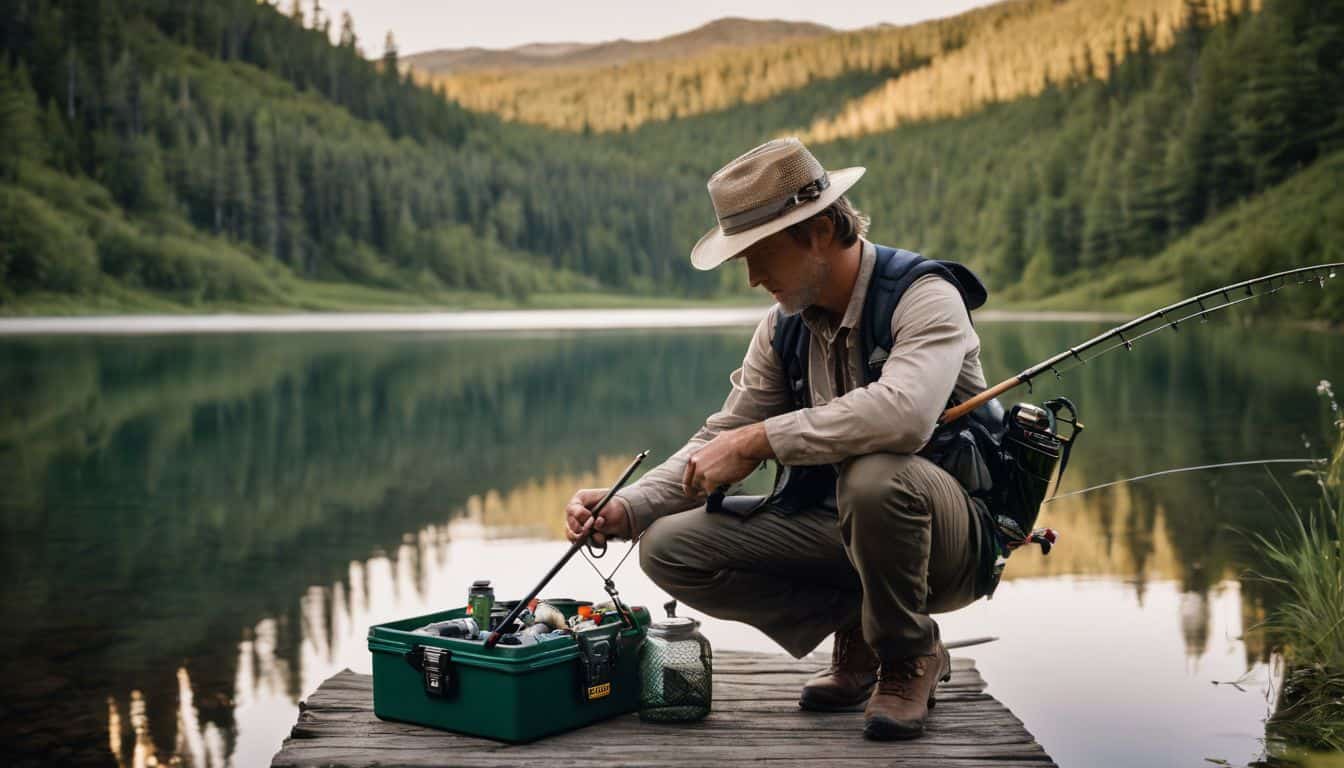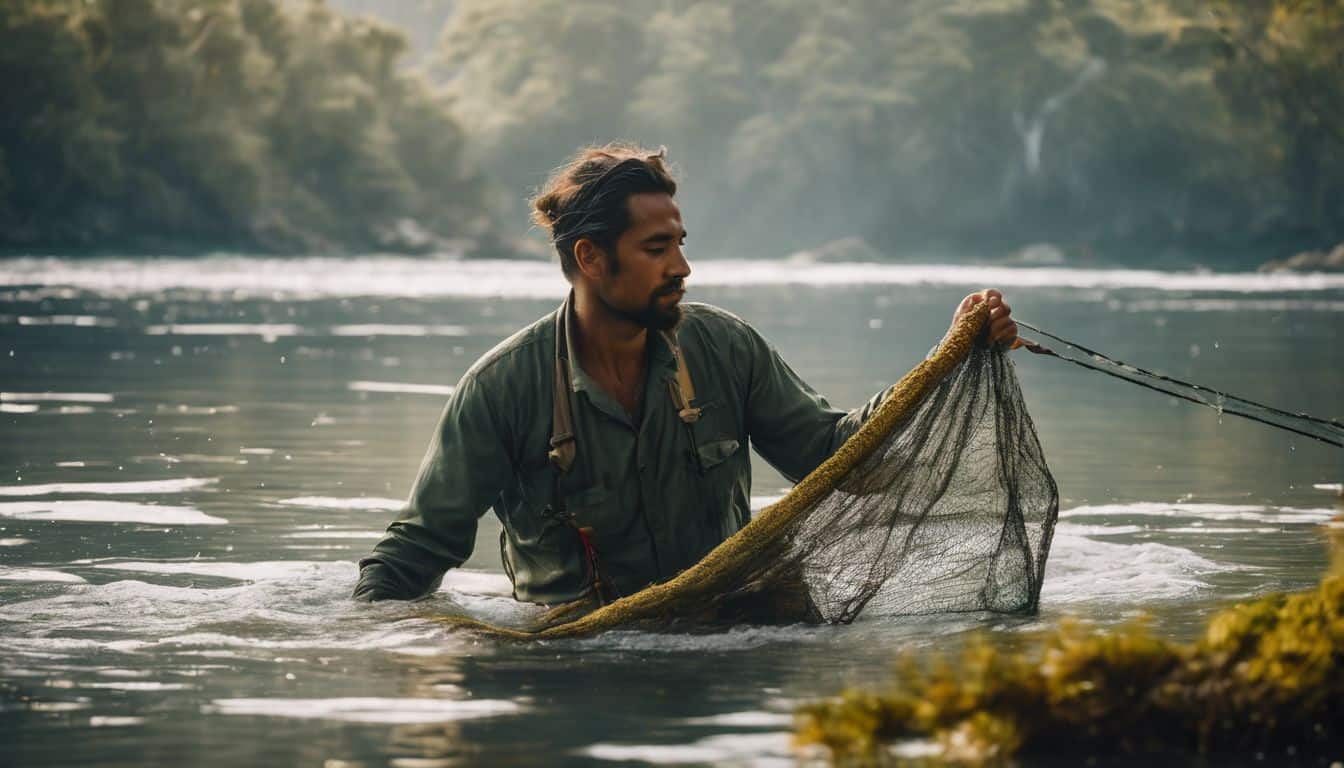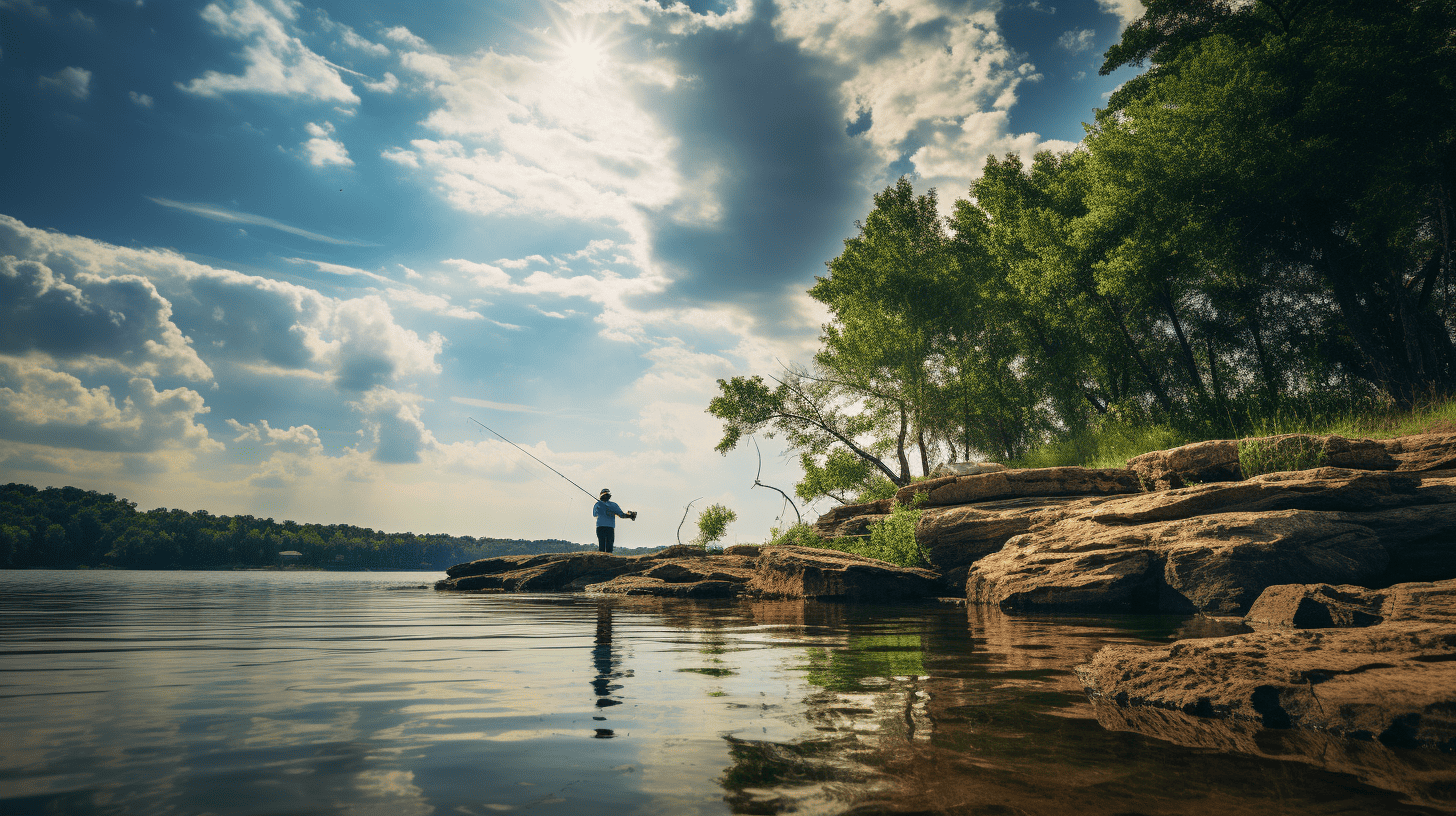Do you find the idea of fishing intriguing, yet feel somewhat bamboozled about where to dive in first? Trust me, I completely understand that feeling! After venturing down numerous rabbit holes of research and clocking up an impressive number of hours with nature as my backdrop, I finally uncovered a number of indispensable hints that gave my beginner’s success rate an encouraging boost.
This guide is your treasure map – illustrating seven pivotal points to set you on course for angling achievement. Are you ready to embark on this thrilling quest towards mastering the art of fishing?.
Key Takeaways
- Choosing the right fishing gear, including rods, reels, lines, and lures, is essential for beginner anglers to improve their chances of success.
- Practicing good fishing etiquette by respecting other anglers and the environment helps create a positive fishing experience for everyone involved.
- Learning basic rigging techniques like tying strong knots, selecting appropriate hook sizes, and adjusting reel drag can significantly impact your fishing success.
- Understanding the importance of colors, shapes, and sizes of lures can help beginners attract fish effectively.
The Right Fishing Gear
When it comes to fishing gear, there are a few key items that every beginner angler should have in their arsenal.
Rods and reels
Picking the right fishing rod and reel is vital. You must feel comfortable with them. They should not be too heavy or too long for you. The stiffness and taper of rods matter a lot, too.
But do not seek a one-size-fits-all solution as it won’t work well in all cases. It’s better to have gear that fits your target fish size perfectly. As a beginner, learn about different types of rods and reels first to up your fishing game.
Fishing lines
Choosing the right fishing line matters a lot. You have many types to pick from. Monofilament lines are common and easy to use. They stretch well and are very visible in the water.
Braid lines are another great choice. They don’t stretch as much but they’re super strong. Fluorocarbon lines are good too, but can be tough to handle for newbies. Finally, fly fishing requires special lines that match your gear just right.
Make sure your guides can take braided line before using it! If your line cuts into the guide, you may end up with a broken line which isn’t fun at all! Always keep this in mind when picking out your gear and setting up for a day of fun on the water.
Lures
Lures play a big role in fishing. I keep lots of lures as part of my gear. They can help catch all kinds of fish. Some lures are made for certain types of fish and places. Using the right lure can make me catch more fish.
Plus, they don’t take up much space, and I can use them many times over! It’s a good idea as a beginner to learn about lures for better results in your fishing trips.
Fishing Etiquette
When fishing, it’s important to always be respectful of other anglers, the fish, and the environment.
Be respectful of other anglers
As a fishing enthusiast, it’s important to always be respectful of other anglers around you. This means being polite, considerate, and cooperative on the water. One way to do this is by keeping a distance from other anglers and respecting their fishing spots.
If you see someone already fishing in an area that you were planning to fish, it’s best to find another spot instead of crowding them. Additionally, following boat etiquette is crucial in maintaining a respectful environment while fishing.
This includes communicating with other boaters, sharing space on the waterways, and resolving any conflicts peacefully if they arise. By treating others with respect and kindness, you can help create a positive fishing experience for everyone involved.
Respect the fish
Respecting the fish is really important when you’re fishing. It’s not just about catching them, but also about taking care of them and the environment they live in. When we respect the fish, it means we practice conservation and sustainability.
We want to make sure that future generations can enjoy fishing too. By practicing ethical fishing and responsible angling, we can help preserve our natural resources and ensure the welfare of the fish.
It’s also essential to follow fishing regulations and laws to protect fish populations and their habitats. Let’s treat these amazing creatures with respect so that they can thrive for years to come.
Respect the environment
Respecting the environment is a vital part of fishing. It means being mindful of how our actions can impact nature and taking steps to minimize any negative effects. One way to do this is by keeping noise levels down while we fish.
By talking softly, avoiding loud music, and using equipment that doesn’t make too much noise, we can help maintain a peaceful and respectful environment for everyone involved. Additionally, it’s important to practice leave no trace principles by cleaning up after ourselves and leaving the area better than we found it.
This includes properly disposing of any trash or fishing line so that wildlife isn’t harmed by our presence. Taking these simple steps shows our commitment to preserving the beauty of nature for future generations.
Basic Rigging
In basic rigging, you’ll learn how to tie strong knots, choose appropriate hook sizes, and adjust reel drag for optimal fishing success. Curious to know more? Keep reading!
Strong knots
When it comes to fishing, tying strong knots is essential for a successful and reliable setup. One popular knot known for its strength and quick tying time is the Clinch Knot. It’s a versatile knot that can be used to attach hooks, lures, or swivels to the fishing line.
Another important aspect of strong knots is using the right technique and keeping it simple. For example, in fly fishing, it’s recommended to focus on a few essential knots rather than mastering numerous complicated ones.
The key is to prioritize reliability and simplicity in your knot tying techniques. So remember, whether you’re catfish angling or freshwater fishing, make sure you use strong knots for your rigging to increase your chances of success on the water.
Appropriate hook sizes
Choosing the right hook size is crucial when it comes to basic rigging in fishing. The size of the hook depends on the type of fish you’re targeting and the kind of fishing rig you’re using.
Hook sizes are measured using numbers or “aughts,” with smaller numbers indicating smaller hooks. Generally, larger hooks are used for bigger fish, while smaller hooks are used for smaller fish.
It’s important to consider that the size of your hook can affect how well your bait is presented and how successful you will be at catching fish. So make sure to select the appropriate hook size based on your target species and enjoy a successful fishing experience!
Reel drag
Properly setting the drag tension on your fishing reel is super important, especially when you’re trying to catch that trophy fish. When the drag is too loose, the fish can easily escape by pulling out line without much resistance.
On the other hand, if it’s too tight, there’s a risk of breaking your line. It’s all about finding that sweet spot. Different types of reels have different drag systems, so they might look a bit different in their design.
Understanding how drag works is kind of like understanding how a clutch works on a power drill – it helps control the amount of pressure and force applied to your line. The pound test of your fishing line also plays a role in determining the right drag setting.

Types of Lures
When it comes to choosing lures for fishing, consider the colors, shapes, and sizes that will attract the fish you’re targeting.
Colors
When choosing lures for fishing, it’s important to consider the colors. In clear water and sunny conditions, light colored lures work best. They are more visible to the fish and attract their attention.
On the other hand, in murky water and cloudy conditions, dark colored lures are recommended. These colors stand out better in less visibility and increase your chances of getting a bite.
Some specific colors that imitate certain prey include green pumpkin for bluegill and crawfish imitation, while white is great for imitating shad and bunker. Additionally, transparent or ghost patterns can also be effective in attracting fish.
Shapes and sizes
Fishing lures come in a variety of shapes and sizes, and each one is designed to attract specific types of fish. It’s important to choose the right size, shape, and color of lure that matches the fish species you’re targeting and their natural prey.
Soft plastic baits are especially versatile because they come in a wide range of shapes, sizes, and colors. The size of the lure is crucial because it can affect how deep it goes in the water and how it moves.
Some lures also have skirts, which add movement and attraction to the bait. So, when selecting your lures, consider both the shape and size to increase your chances of success on your fishing trip!

Essential Tips for Beginners in Achieving Fishing Success
As a beginner in fishing, there are some essential tips that can help you achieve success on your fishing trips. One important tip is to invest in the right fishing gear. This includes getting the appropriate rods and reels, choosing the right fishing lines, and selecting the right lures for different types of fish.
Another important tip is to practice good fishing etiquette. Be respectful of other anglers by giving them enough space and not casting near their lines. Respect the fish by handling them properly and releasing any undersized or protected species.
Also, respect the environment by cleaning up after yourself and avoiding littering.
Learning basic rigging techniques is also crucial for beginners. Knowing how to tie strong knots, using appropriate hook sizes, and adjusting reel drag can make a big difference in your fishing success.
Additionally, familiarize yourself with different types of lures. Experiment with colors, shapes, and sizes to see what works best for attracting fish in different conditions.
Remember that learning how to fish can be overwhelming at first, but don’t get discouraged! Keep practicing and seeking knowledge from experienced anglers or online resources. Being patient and persistent will eventually lead you to become a successful angler.
One final tip for beginners is to always use sharp hooks. The sharpness of the hook is crucial because it determines whether you’ll be able to successfully catch a fish or not. Make sure to regularly check your hooks or replace them if they become dull.
Keep these essential tips in mind as you embark on your journey as a beginner angler!
Best Time to Fish
Consider factors such as weather conditions, water temperature, and fish feeding patterns to determine the best time to go fishing; freshwater and saltwater fishing may have different optimal times.
Factors to consider
The best time to go fishing is an important factor to consider. Early morning or late evening are the optimal times because there is an abundance of food and fish are more likely to be feeding.
The season and bait you use can also influence the best time to fish. Tides play a role too, so it’s important to understand them and how they affect fishing. By considering these factors, you can increase your chances of success when out on the water!
Different times for freshwater and saltwater
The best time to fish can vary depending on whether you’re saltwater fishing or freshwater fishing. In saltwater, dawn and dusk are generally considered the ideal times to go fishing if the weather and tidal movements are favorable.
This is because during these times, fish tend to be more active and feeding near the surface. On the other hand, in freshwater, the timing of high or low tides doesn’t have much impact because there are no tides in lakes or rivers.
Instead, factors such as weather conditions and water temperature play a bigger role in determining when it’s best to go fishing. So, it’s important for beginners to consider these factors and do their research before heading out on their fishing trip.
Tides and Currents
Tides and currents play a crucial role in fishing as they greatly affect the behavior of fish and their feeding patterns.
How they affect fishing
Tides and currents have a big impact on fishing. When the tides are moving, it can help concentrate fish in certain areas. It’s important to pay attention to these tidal movements because they can affect where the fish are and how they behave.
However, it’s important to note that tide charts aren’t always accurate because there are many factors that determine the tide and current, like the moon phase, wind, temperature, and water clarity.
So when planning your fishing trip, make sure you take into account these elements as they greatly influence your strategies and success in bays and inlets.
Researching patterns
One important aspect of fishing is researching patterns. This involves studying tides and currents, as well as marine life and the fishing season. By understanding how these factors interact, you can improve your chances of success on your fishing trips.
For example, knowing when the tide is coming in or going out can help you determine the best time to cast your line. Additionally, being aware of water levels and coastal areas can give you insights into where certain fish might be located.
It’s also essential to stay informed about any fishing regulations and changes in the ecosystem dynamics due to climate change. Doing proper research before heading out can greatly enhance your overall fishing experience.
Do Your Research
To ensure success in fishing, it is important to do thorough research on the various species and their habitats, as well as the regulations and laws governing fishing in your area.
This will help you understand which techniques and baits work best for each fish, and ensure that you are abiding by all legal requirements while enjoying your time on the water.
Species and habitat
It’s important for beginner anglers like us to understand the different species of fish and their habitats. By doing our research, we can learn about the biodiversity, ecosystems, and marine life that exist in our fishing spots.
This knowledge will help us make informed decisions on the best fishing techniques and gear to use. Additionally, understanding the importance of conservation and habitat restoration will ensure we can continue enjoying fishing for years to come while protecting our environment.
Let’s do our part in preserving these beautiful habitats for future generations!
Regulations and laws
When it comes to fishing, it’s important to follow regulations and laws. These rules help protect our fishery resources and ensure sustainability for future generations. Under the Magnuson-Stevens Fishery Conservation and Management Act (MSA) in the U.S., fisheries management is a collaborative process involving science, innovation, and cooperation with the fishing industry.
State fish and wildlife agencies play a crucial role in enforcing these regulations. Bag limits are in place to control the amount of fish you can take home, while catch-and-release policies protect certain species.
By following these rules, we can all contribute to preserving our fishing opportunities for years to come.
Trolling
When it comes to trolling, using a boat can greatly increase your chances of success in catching fish.
Using a boat
Using a boat for fishing opens up a whole new world of angling opportunities. Whether you’re trolling in lakes, seas, or other open waters, being on a moving boat allows you to cover more ground and explore different areas.
When it comes to using a boat for fishing, having the right gear is essential. Make sure your rod and reel are strong enough to handle bigger fish that may come your way. Additionally, choosing the right trolling lures can greatly increase your chances of hooking that big catch.
Trolling can be done in both freshwater and saltwater environments, so keep in mind the specific conditions and species you’re targeting when selecting your gear and techniques. So hop on board and get ready for an exciting angling adventure!
Types of lures
When it comes to fishing, using the right lure can make a big difference in your success. There are different types of lures that work well for trolling. Some popular ones include crankbaits, spoons, and swimbaits.
These lures are designed to mimic the movement of baitfish and attract predatory fish. Skirted lures are great for chasing bigger fish, while soft plastics work better for smaller game.
Jigs, plugs, and spinners are other common types of lures used for trolling. Each has its own unique characteristics and movements that can entice fish to bite. So when you’re out on the water, be sure to choose the right lure based on the type of fish you’re targeting and the conditions you’re fishing in.
Conclusion on Beginner’s Guide To Fishing
In conclusion, these 7 essential tips for a beginner’s guide to fishing achievement will help you get started on the right foot. By understanding and selecting the right fishing gear, practicing proper fishing etiquette, mastering basic rigging techniques, and using the right lures, you’ll be well on your way to successful fishing trips.
Remember to do your research on species and regulations, consider the best time to fish based on factors like tides and currents, and take advantage of resources like knot-tying videos and fishing guides tailored for beginners.
Happy fishing!
FAQs on Beginner’s Guide To Fishing
1. What are the essential tips for beginners to achieve success in fishing?
The essential tips for beginner’s fishing success include choosing the right fishing gear, learning basic casting techniques, understanding different types of baits and lures, knowing where to fish, and practicing patience.
2. Do I need a fishing license as a beginner?
Yes, it is important to obtain a fishing license before you start fishing. Fishing without a license can result in fines or penalties depending on your location.
3. How do I choose the right fishing gear?
When choosing fishing gear as a beginner, consider factors such as the type of fish you want to catch and the location where you will be fishing. Start with a medium-sized rod and reel combo that is easy to handle.
4. Where is the best place for beginners to fish?
For beginners, it is recommended to start with local ponds or lakes that have easily accessible shorelines. These areas usually have abundant fish populations and provide a good learning environment.
5. What should I do if I don’t catch any fish while fishing?
If you’re not catching any fish while fishing, try changing your bait or lure, adjusting your casting technique, or moving to another spot. Remember that patience and perseverance are key in successful angling.





Leave a Reply